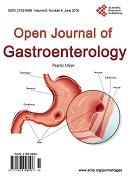Background: Pruritus is a distressing symptom of cholestatic, inflammatory,and malignant liver diseases. It is a common symptom in many biliary andcholestatic disorders such as primary biliary cirrhosis (PBC). Several mechanisms are generally accepted as possible explanations to the underlying basis of itch.However, the exact pathophysiology of pruritus in liver diseases remains unclear.The cutaneous and central neurobiology of pruritus is complex and underlies a regulation of variable mechanisms. At present, not all mechanisms including neuromediators and receptors are known.
Objective:
Our objective is to evaluate whether the expression pattern of NGF and its receptor TrK A has a role in pruritus in a group of Egyptian cirrhotic patients.
Patients and Methods:
Forty Patients with liver cirrhosis were enrolled in the study depending on clinical evidence of stigmata of chronic liver disease (e.g. jaundice, ascites, palmar erythema, spider naevi, etc. ) and ultrasonographic features of liver cirrhosis (e.g. coarse echo texture, shrunken liver, etc.). Patients were divided into two groups. Group (1): included 20 patients cirrhotic patients without pruritus.Group (2):included 20 patients cirrhotic patients with pruritus. A group of age and sex matched healthy twenty volunteers as a control. Results: After evaluation of histopathological using hematoxylin and eosin stained sections (H&E) was done. There was positive correlation between NGF protein expression and severity of pruritus in cirrhotic patients with pruritus (r = 0.876, p value ≤ 0.001). Also there was positive correlation between TrK A protein expression and severity of pruritus in cirrhotic patients with pruritus(r=0.44,p value≤ 0.05).
Conclusions:
We report, for the first time, role of these proteins (NGF/TrK A) in the mechanism of pruritus in cirrhotic patients and may provide a potential target for new treatment of pruritus in cirrhotic.


